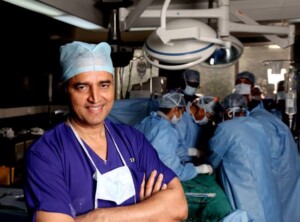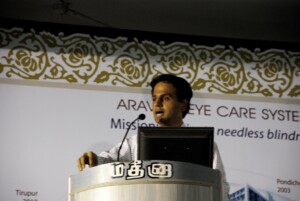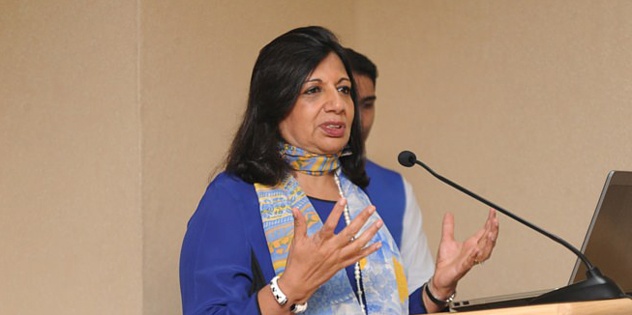There are many things about India that are inexplicable – its laxity in letting its phenomenal strengths in healthcare go unexploited – is one of them. Myopic vision and poor policy making over the years have led to not only denial of basic healthcare to a majority of its 1.3 billion people but a refusal to see India as a potential global healthcare superpower. What’s worse, belligerent policy-making is even derailing the growth of the private sector healthcare enterprise.
“I think our policy makers have failed us,” says Kiran Mazumdar Shaw. “We have islands of excellence but if we are to progress we need to connect the dots.”
The trillion dollar question is – why is India’s healthcare in such a sorry state. The heart of the predicament, the Biocon founder believes, is because of the trust deficit between the policy makers and the private sector. This is true not only in a vital sector such as healthcare and education but also in the entire business sector.
One thought the pace of economic reform process that started in 1991 would result in India developing into a vibrant economy. Despite growing briskly, although calculated from a very low base, the economy is yet to break shackles in vital sectors such as education and healthcare. In fact, there are ample signs of India returning to the dreadful age of the license raj with stifling price control and red tape.
“The government is myopic about healthcare. It is focusing on price control which is killing enterprise and innovation,” Ms Shaw said during a chat with this writer a few days ago.
 This sounds like a narrative of the 1980s but strangely is relevant even today. What then is the solution? In one of his recent TED talks Dr. Devi Shetty said the solution lies in seamlessly marrying the 3Es – equity, efficiency and enterprise. One at the cost of the other will fail all the three.
This sounds like a narrative of the 1980s but strangely is relevant even today. What then is the solution? In one of his recent TED talks Dr. Devi Shetty said the solution lies in seamlessly marrying the 3Es – equity, efficiency and enterprise. One at the cost of the other will fail all the three.
For example, forty two year old Aravind Eye Hospital has demonstrated that the 3E formula is workable and is also profitable. The world’s largest eye care provider, with a half a million surgeries in 2017, offers 50% of its services free of cost. With McDonald- style process model, community welfare driven work culture and a purpose-led leadership, the hospital’s story is a much discussed case study in global business schools. All this was possible partly because the Tamil Nadu government has not been interfering.
 Dr. S Aravind, a trustee on the Aravind Eye Hospital board, told this writer recently that 90% of the paying patients don’t even know they are subsidizing the poor because what they pay is much lower than what corporate hospitals charge.
Dr. S Aravind, a trustee on the Aravind Eye Hospital board, told this writer recently that 90% of the paying patients don’t even know they are subsidizing the poor because what they pay is much lower than what corporate hospitals charge.
Dr. Devi Shetty’s Narayana Health City, Aravind Eye Hospital, Biocon and cancer care provider HCG are easily a few of the most successful entrepreneurial affordable healthcare ventures in India. There are a few generic drug manufacturers as well who can make it to this list. Their phenomenal success is despite or little support from the governments.
Next Big Idea is From India
Yet, Dr. Shetty is optimistic that “The next big thing in healthcare is going to come from India because of the power of IT, simulators to train critical care nurses, cloud computing, artificial intelligence, availability of cheap human resources among the few.” And India could be the first country that will disassociate affluence with healthcare. All this can happen faster with a supportive policy environment.
A well-funded and efficiently run universal health care is no longer a dream as, unlike before, it’s not the lack of resources or the ability, but the absence of political will. The only way this can happen is when voters demand universal healthcare with well-run public hospitals as their right.
It’s clearly the responsibility of the governments – both central and states – to multiply the scale the private sector has built by at least ten times. A beginning can be made by raising the percentage of funding public healthcare from 1.2 to 2% of GDP. A nation of healthy people translates into a healthier economy.
Ms Shaw says a beginning can be made by “an understanding of what each brings to the equation and fostering them at larger scale.” However, it may seem that the private sector healthcare leaders have failed in making policy makers ‘understand this equation’ or the policy makers have been too obstinate.
Asked why the leaders have failed in influencing public healthcare policy, Ms. Shaw says: “It’s very difficult. It’s possible to influence policy if both are on the same side. But if you have policy makers who are suspicious or don’t trust the other side, there is no way forward.”
One of the reasons for the logjam is because too many ministries are involved in policy-making. “Each one is pulling and pushing in different directions. We cannot solve this riddle unless everyone is on the same page. This can happen only if the government recognizes the country’s value and leadership potential of healthcare. No government has so far recognized healthcare as an opportunity.”
Some Beginning
Karnataka has been a pioneer in allowing the private sector to take the lead in information technology and biotech despite recent measures to control prices of vital healthcare products. It has also shown interest in the Vision of Biotechnology Group’s draft policy on ‘Rare Diseases and Orphan Drugs Policy’. But the draft, accepted in July 2017, is yet to be announced as a policy.
This is the first such policy draft by any state on rare diseases. Niti Ayog is said to have taken notice and exploring ways of incorporating it in its own version of the draft policy.
This policy is of immense significance to India as roughly 70 million, largely children under 5, don’t get access to healthcare facility if they have a rare disease. They also don’t get covered by insurance either. Not sure if the recent universal insurance plan of the GOI covers this.
The biggest policy breakthrough in Indian healthcare has been on biosimilars. The Association of Biotechnology-led Enterprises (ABLE) has managed a coup of sorts. According to the Generics and Biosimilars Initiative (GaBI), the first “similar biologic” was approved and marketed in India in 2000 — some 15 years before the U.S. approved its first biosimilar. “India also has a much more mature biosimilar manufacturing ecosystem and regulatory environment than most other parts of the world. As such, the country can provide valuable lessons about what it takes to establish a thriving biosimilar market in terms of accessibility, competition, regulatory strategy, and other facets.”
It’s high time such breakthroughs are replicated in all other aspects of healthcare products and delivery. It’s possible the bureaucrats saw biosimilars as manufacturing commodity and not as part of healthcare. It’s clear healthcare needs more such luck.
Healthcare next IT
Already, India is a role model not just to the developing world but also to the developed in many areas of healthcare, both services and manufacturing of essential drugs. But again, the difference between the potential and what has been achieved is massive.
India could gain tremendously if it looked at the world as a healthcare market to be severed by Indians just like what Indian software services did in the last two decades.
Unlike IT and ITES which are still dependent on the Western markets for revenue and growth, India itself is a big healthcare market eagerly waiting to be served. But if the potential of both domestic and global markets are combined, the Indian economy can address most of its current seemingly insurmountable problems such as unemployment and employability, especially of women who take to healthcare more easily.
The current health infrastructure like manufacturing medical equipment, labs, medical services, medical IT and all other associated segments that will be needed might double. This might easily lift the GDP by two to three percent.
What IT did to a few cities like Bangalore, Hyderabad and Gurgaon, healthcare could transform dozens of Indian cities into healthcare hubs.
Healthcare in Election Manifesto
The current central and state governments seem to have missed the bus on healthcare reforms. With elections to several state assemblies coming up in the next few months and national elections a year or so ahead, can healthcare be brought to the top of parties’ manifesto?
The healthcare sector leaders could do well in raising the level of debate, dialogue and education both with political leaders and the electorate. A massive social media and traditional media campaign might help create the buzz.
Only by turning healthcare into a political issue and galvanizing people to demand decent and affordable healthcare services can leaders hope to draw the attention of the future policy makers. It might even wean people, even if slightly, away from divisive caste and communal politics that seem to dominate elections.







